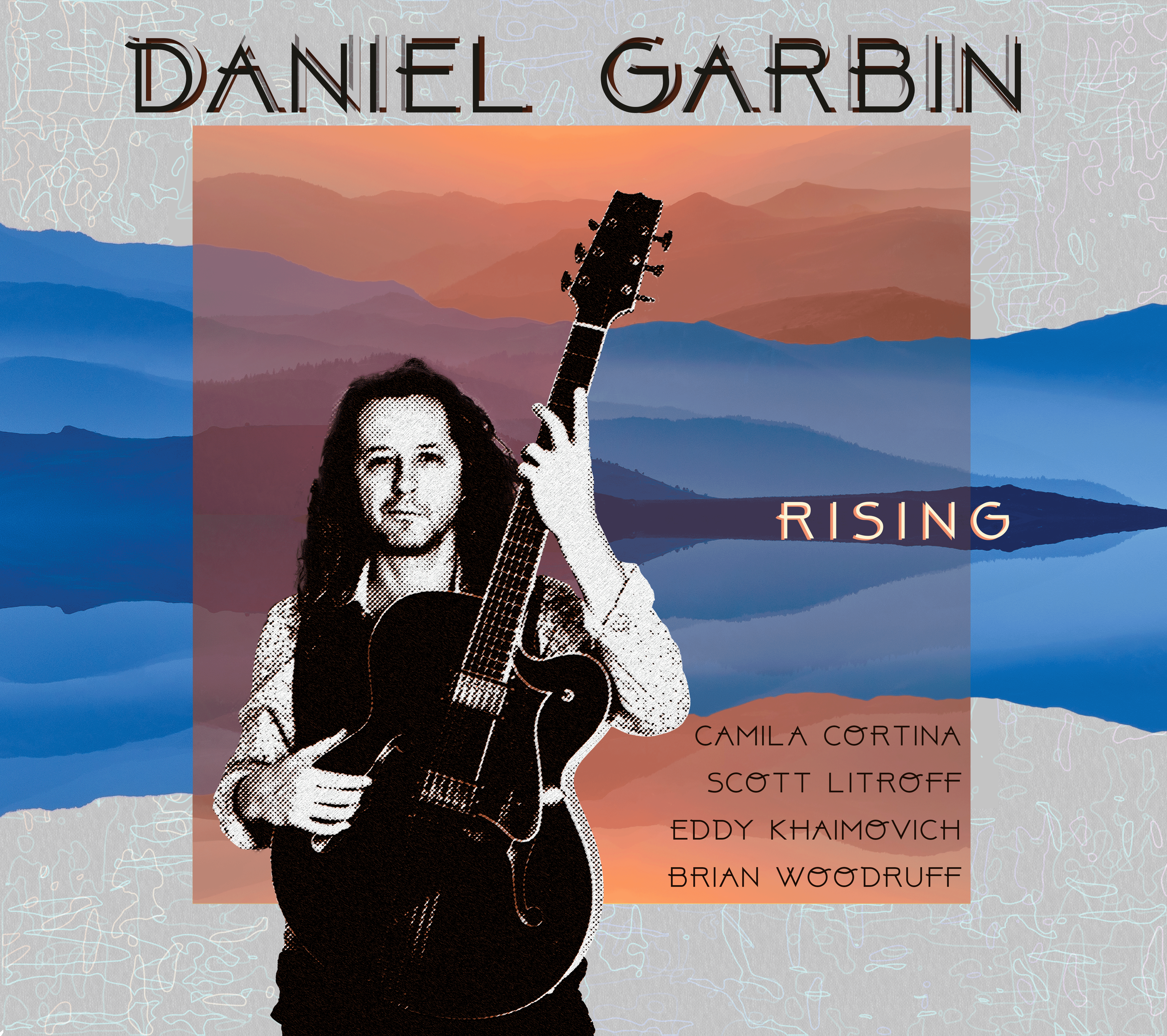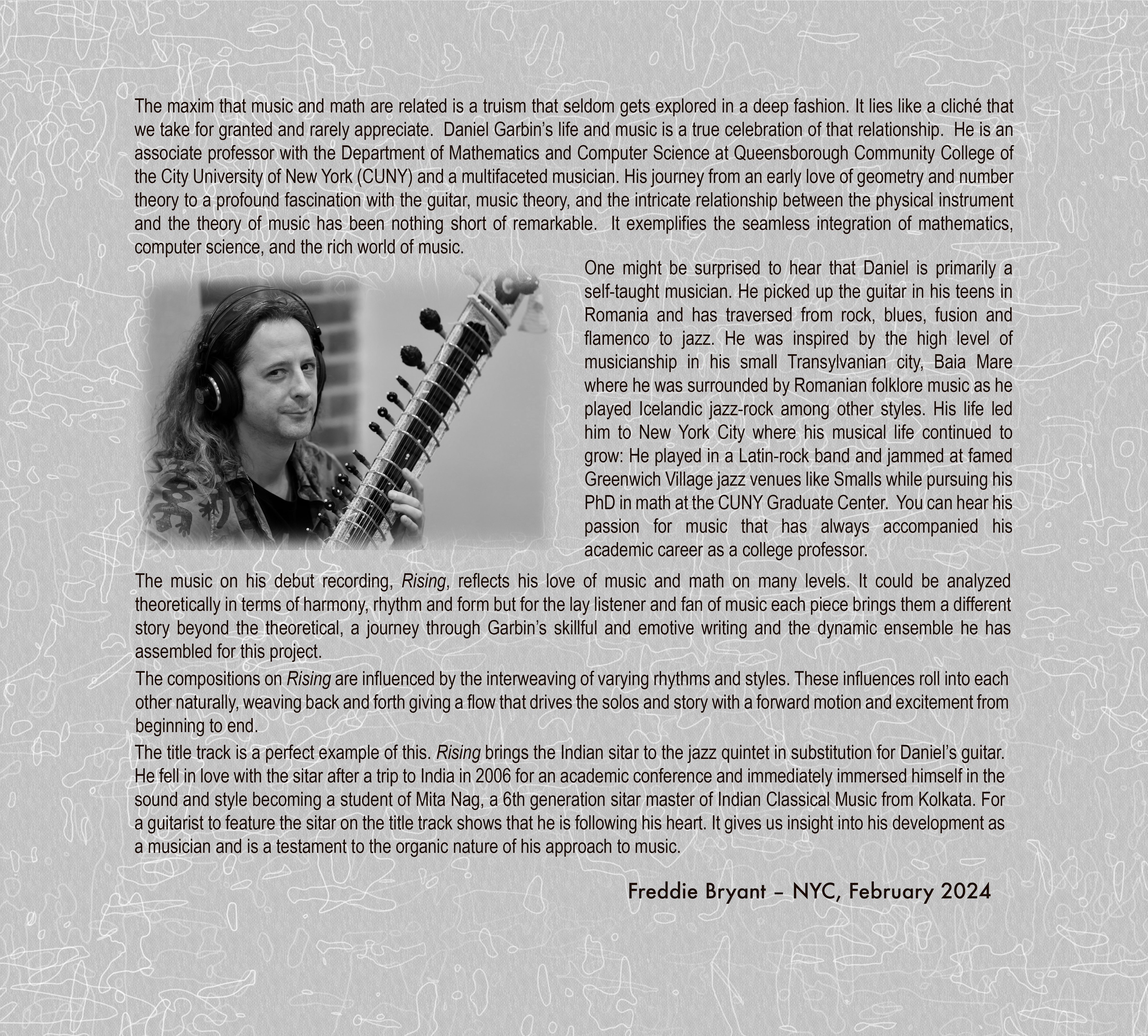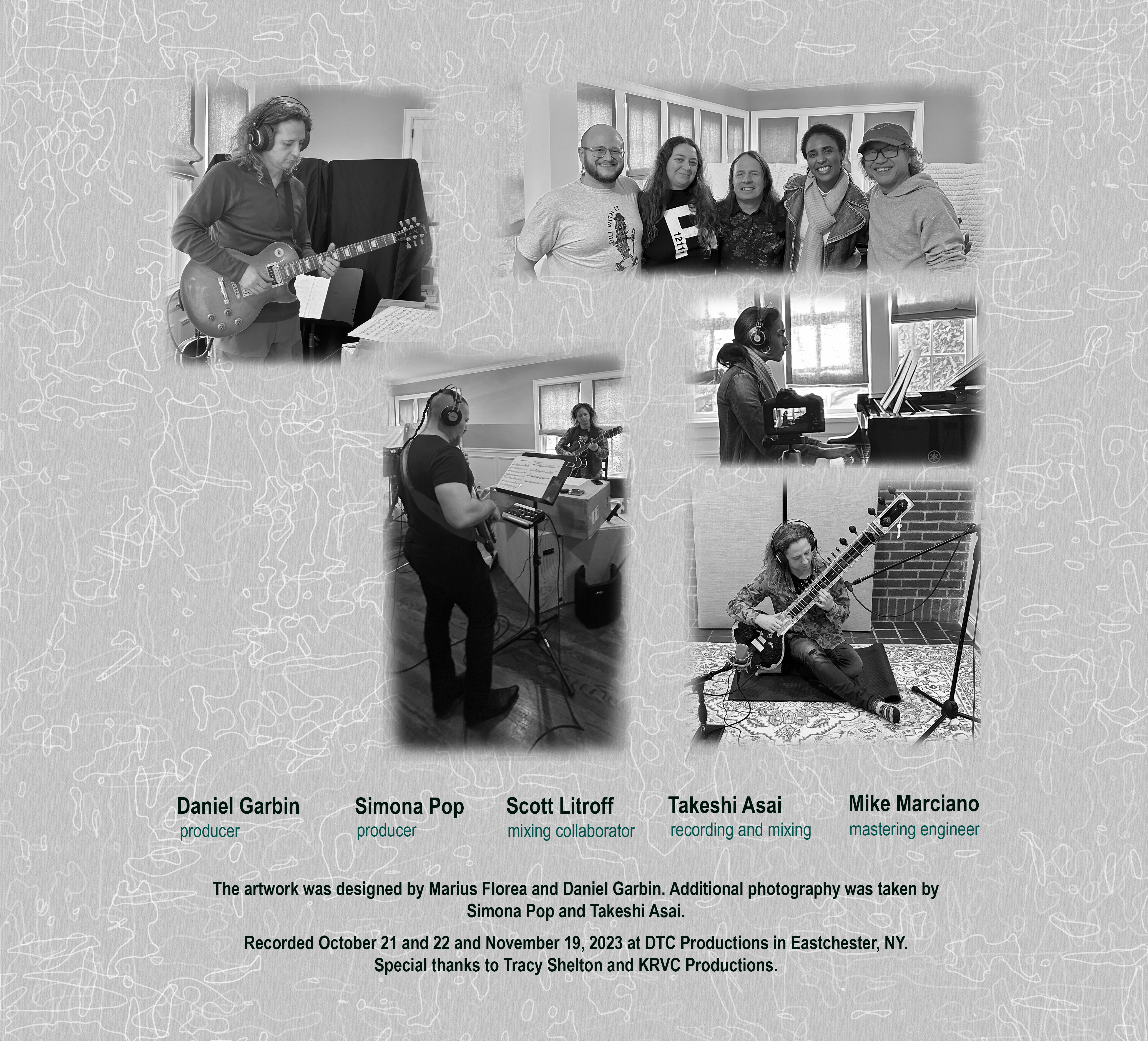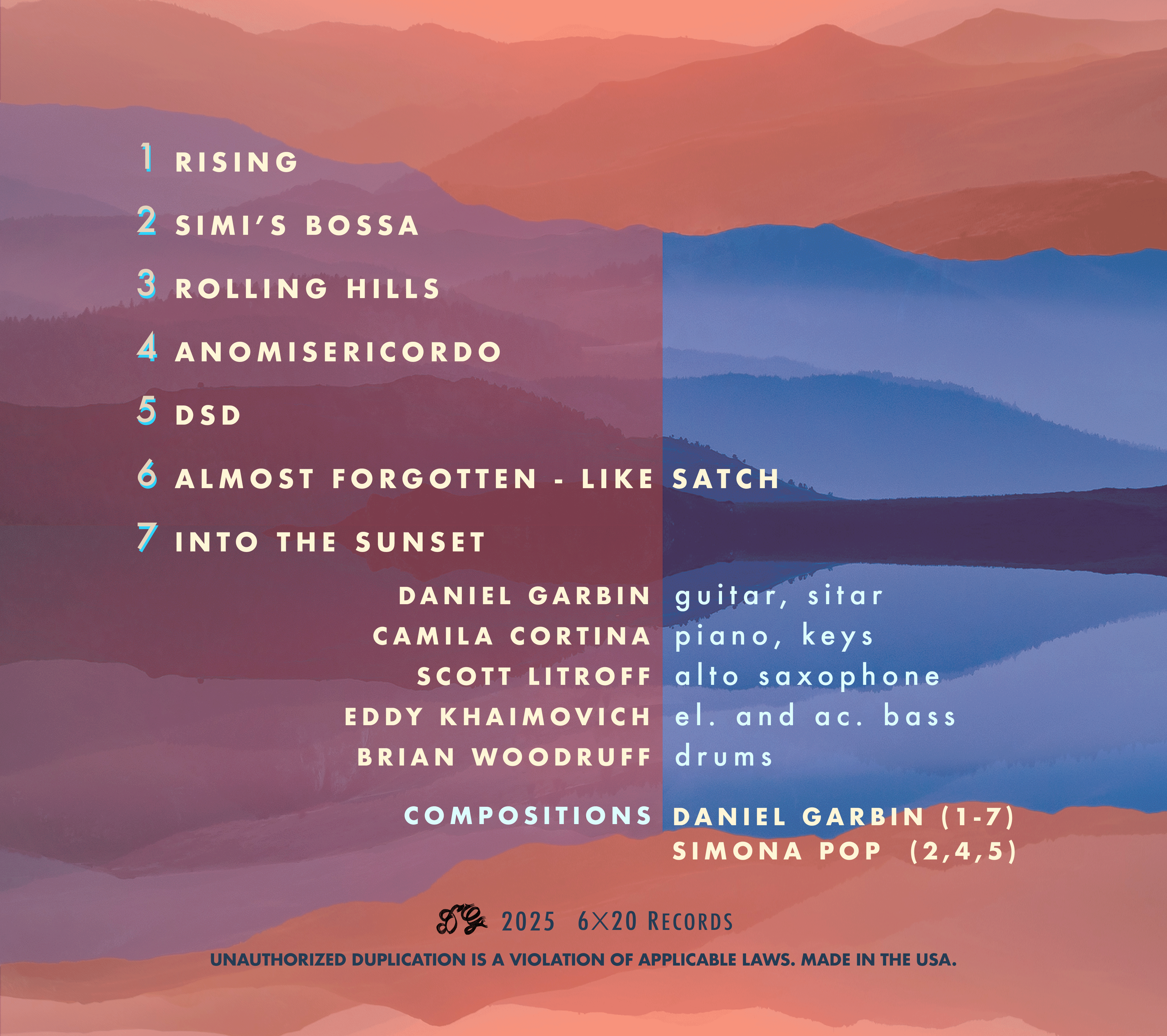Rising
The album Rising by Daniel Garbin is a musical odyssey that unfolds from years of intricate
exploration and creative evolution.
Drawing inspiration from daily guitar exercises, diverse music styles, various cultural influences, and
the pattern-filled world of Mathematics, Garbin masterfully combines jazz
with Indian classical music and hints of flamenco, Romanian folklore, and even rock. The compositions of
Rising, each a story in itself,
showcase Garbin's facility in weaving melodies and harmonies.
The eponymous track marries a rumba-like rhythm with Indian classical influences, a composition where Garbin plays the sitar.
Collaborating with Simona Pop on pieces like
Simi’s Bossa (a "nouveau bossa"), DSD (a smooth jazz with Andalusian melody), and
Anomisericordo (a Cuban cha-cha with chromatic melodies), he effortlessly blends musical elements, creating a fusion of genres where
melody is central. From the uplifting
Almost Forgotten – Like Satch to the lush serenety of
Into the Sunset, Rising offers a rich tapestry of emotions and experiences.
This album is not just a collection of songs;
it's a sonic journey, a proof to Garbin's musical ingenuity and the manifold influences that shape his captivating sound.
For Rising live performances, click here.
Liner Notes by Freddie Bryant
One might be surprised to hear that Daniel is primarily a self-taught musician. He picked up the guitar in his teens in Romania and has traversed from rock, blues, fusion and flamenco to jazz. He was inspired by the high level of musicianship in his small Transylvanian city, Baia Mare where he was surrounded by Romanian folklore music as he played Icelandic jazz-rock among other styles. His life led him to New York City where his musical life continued to grow: He played in a Latin-rock band and jammed at famed Greenwich Village jazz venues like Smalls while pursuing his PhD in math at the CUNY Graduate Center. You can hear his passion for music that has always accompanied his academic career as a college professor.
The music on his debut recording, Rising, reflects his love of music and math on many levels. It could be analyzed theoretically in terms of harmony, rhythm and form but for the lay listener and fan of music each piece brings them a different story beyond the theoretical, a journey through Garbin’s skillful and emotive writing and the dynamic ensemble he has assembled for this project.
The title track is a perfect example of this. Rising brings the Indian sitar to the jazz quintet in substitution for Daniel’s guitar. He fell in love with the sitar after a trip to India in 2006 for an academic conference and immediately immersed himself in the sound and style becoming a student of Mita Nag, a 6th generation sitar master of Indian Classical Music from Kolkata. For a guitarist to feature the sitar on the title track shows that he is following his heart. It gives us insight into his development as a musician and is a testament to the organic nature of his approach to music.
The song’s inspiration came in part through an exercise he was playing on the sitar. The modal melody floats over a rumba-like rhythm. Since rhythm plays such a major role in Indian music, Garbin felt that the time signature of 4/4 in the main melody should alternate with the 3/4 time signature (interlaid with a fast 6/8) during the interlude. But much like in Indian classical music, the melody dominates over the time signatures, with the
The compositions on Rising are influenced by the interweaving of varying rhythms and styles. Take Rolling Hills which starts with a medium Latin groove, then goes to a fast 12/8 African inspired rhythm and then to swing in the American jazz tradition. These influences roll into each other naturally, weaving back and forth giving a flow that drives the solos and story with a forward motion and excitement from beginning to end.
Then you have the contrast of Simi’s Bossa and Anomisericordo two beautiful pieces that evoke Brazilian and Cuban influences and rhythms. Both are co-written by Simona Pop who is also a co-producer of the project. A third collaboration between Garbin and Pop is DSD, a track that has an even 8th note, smooth-jazz to funk feel (with some slap-bass from Khaimovich). After a rhythmic band break there’s a contrasting melody that is almost Andalusian with a middle-Eastern flair.
DSD combines with two other songs that show more influences from jazz-rock, smooth jazz and fusion: Almost Forgotten – Like Satch, a dedication to Joe Satriani and Into the Sunset, which has a Pat Metheny lilt to its harmony and melody. All are based on strong melodies that connect with the harmony and rhythm and each track is propelled by a collective group dynamic from the ensemble – great solo playing with equal attention to communal support. Into the Sunset is a great example. Listen to the dramatic solos and you’ll also note the beautiful accompaniment by the rest of the band. Each instrument is a joy to listen to - five individuals making a great band!
Finally, Daniel’s solo on this track is the perfect ending to his recording project. It starts out with guitar effects, spare and minimal, sliding up and down, from low to the stratosphere with ethereal sounds. Then he gets funky and rhythm takes over with some wailing and shredding and then back into the pastoral, lyrical melody. The drama he creates in this solo is a microcosm of the drama of this set of seven songs. Take the journey with him and his band from beginning to end.
Freddie Bryant, NYC February 2024
Personnel
| Daniel Garbin | - guitar, sitar, producer |
| Scott Litroff | - alto sax, mixing collaborator |
| Camila Cortina Bello | - acoustic and electric pianos |
| Eddy Khaimovich | - double bass and electric bass |
| Brian Woodruff | - drums |
| Simona Pop | - producer |
| Takeshi Asai | - recording engineer, mixing |
| Mike Marciano | - mastering engineer |
Tracks
| 1 | Rising |
| 2 | Simi's Bossa |
| 3 | Anomisericordo |
| 4 | Rolling Hills |
| 5 | DSD |
| 6 | Almost Forgotten - Like Satch |
| 7 | Into the Sunset |
All music was written by Daniel Garbin. Simona Pop is a co-writer on tracks 2, 3, and 5.
The music was recorded in October 2023 at DTC Music Productions in Eastchester NY. The mastering
of the album was made at Systems Two in Long Island NY, during January 2024. Funding for the recording
was provided in part by KRVC Productions.
The photo on the cover of the album is courtesy of Simona Pop
while the graphic design is courtesy of Marius Florea.











